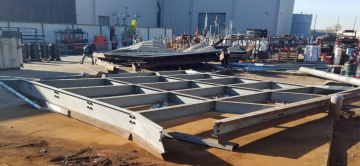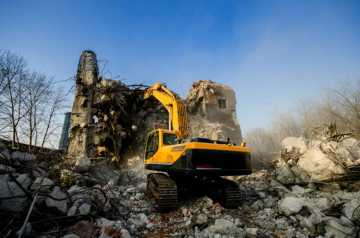When exiting a facility for any reason, such as lease exportation, manufacturing shutdown, operations relocation, termination of business, etc., there is a long list of to-dos. Many of the activities on this list are not typical operational functions. Often businesses attempt to continue normal operations until the last possible moment, thereby keeping their normal staff occupied with their assignments and accountabilities - but someone needs to begin the planning process for operational shutdown, plant closing, and maybe even facility demolition.
If decommissioning a site isn’t part of your day job (so, almost all of us) it can be a stressful process that tests your sanity. Knowing what you're up against can help the process run smoothly, on time, within budget, and reduce stress. Below we cover the basics of what you need to know when exiting a facility and/or decommissioning assets.
What does it mean to decommission an asset or facility?
Decommissioning a facility means to terminate its current function which could be manufacturing, research and development, warehouse, office building, or other commercial businesses, and make the facility safe. This involves many different tasks described below but also depends on owner (or lessor) expectations for future use of the facility and the equipment within the facility.
Facility Closing Checklist
Some of the tasks to consider when exiting a facility are presented below. As mentioned before, if closing a facility isn’t a regular part of your job it can be challenging and confusing. Often additional resources are needed for these tasks to ensure everything is done and done correctly.
Facility closings can include:
- Regulatory notifications
- Lessor notifications and lease compliance obligations
- Real estate agreements for land sale
- Permit closings or ownership changes
- Equipment relocation or disposal
- Raw materials and supply inventory management
- Waste documentation and disposal
- Waste stream minimization by recycling
- Decommissioning or Demolition plan
- How the final disposition of the facility and next use can impact the closing
- Stakeholder engagement
- Cleaning the facility to meet both lease and regulatory requirements - “how clean is clean?”
- Safety management – many atypical activities are occurring during facility closure
- Monetization of shut down operations - what are the best practices for remaining materials and products, equipment, and land use
ESG Implications
When exiting a facility, there are many environmental, social, and governance (ESG) implications to consider. You have to ask yourself - how will this process impact the environment? The community? The employees? Below are just a few of the key ESG considerations to keep in mind when decommissioning a facility.
- Be sure to capture the data for any materials that are recycled or disposed of during the process so they can be included in your ESG (or sustainability) report
- Document the process to ensure oversight for both people and planet
- Donate or recycle as much as possible - reach out to local groups such as charities, schools, or other community groups with items they may need. For example – if there is a large amount of cleaning rags or towels they could be donated to local animal shelters.
- Go above and beyond all regulations to reduce negative impacts on the surrounding environment and community
- Have a plan for your employees, not just the facility (are they going to be losing their job, transferring to another facility, etc.)
Real-World Examples
Example #1 – Manufacturing Facility
Challenge
A manufacturing facility is merging two facilities and one facility will be vacated and returned. The lease at the vacated facility is over 30 years old, and the lease language requires the facility to be “returned to original condition”. Modifications were made to the facility for process equipment that requires repair and chemical processes may have left residual impacts on the building structure.
Upon removal of the production equipment for transfer to the new facility, evidence of chemical releases is identified beneath some of the equipment and tanks. The lease termination has a fixed date and penalties for noncompliance. The lessee and lessor have a substantial difference of opinion on original condition versus the current condition of the facility and, in addition, the regulatory agency has its own expectations for facility closure.
Solution
For this situation, a clearly defined decommissioning plan prepared well in advance of the lease termination is recommended. Engaging the lessor and regulatory agency for input and approval in this plan is also recommended so that there are no surprises. Addressing the difficult issues such as “return to original condition” are best resolved well in advance and defined expectations are clear and agreed to.
Example #2 – Chemical Manufacturing Facility
Challenge
A chemical manufacturing facility had an 8-week timeline to decommission a facility. This included 20 tanks and chemical mixing vats, piping, transfer pumps and hoses, emission controls, and process equipment associated with the facility. Due to the remaining chemicals, hazardous residuals, and process equipment, the property would potentially lose value if not properly decommissioned.
In addition to the challenges of hazardous residues and chemicals, the facility also presented risks such as confined space, hot work, lock-out/tag-out, and working at heights to complete the job.
Solution
A facility-wide risk analysis, job safety analysis, and HASP were developed and all SDSs were reviewed prior to project initiation to identify site-specific and chemical hazards. Two crews worked simultaneously to complete work strategically in sections by tank type and chemical. Chemical residuals remaining in tanks and rinsate from decontamination were processed through the facility’s Wastewater Treatment Plant as allowed under the system’s permit.
The project scope included termination of all regulatory permits including achieving regulatory closure and demolition of the facility’s permitted industrial wastewater treatment facility.
Example #3 – Oil Terminal & Blending Facility
Challenge
A global oil and gas company required final decommissioning at a former terminal and blending facility that had been idle for almost a decade. The site required the removal of all above and below ground structures, underground utilities, process equipment, buildings, concrete slabs, and foundations.
Several factors contributed to the complexity of the project including site location immediately adjacent to neighbors with high-pressure LNG lines, round the clock high truck traffic, incomplete site records and historical information, asbestos-containing materials and petroleum waste, high risk permitted safety activity, the workforce being from multiple countries speaking different native languages and continuous coordination and interactions with the port authority.
Solution
Specific activities performed during the decommissioning process included preparation of safety documentation, industrial hygiene and site security planning, workforce training, permitting support for hot work, working at heights and ground disturbance, waste management tracking and reporting, air monitoring, and stakeholder engagement.
Antea Group coordinated with a demolition contractor for the final removal of site assets and supervised all demolition activities.
Assets cleared from the site included:
- 20 above-ground storage tanks and related piping
- 6 underground storage tanks and related piping
- A boiler house, metal fabricating plant, blending plant, additive warehouse, laboratory, office building, and service shop
- 1250 cubic meters of Asbestos-containing material removed
- 1010 metric tons of scrap metal
- 3200 cubic meters of oil impacted soil removed
What you can do to reduce stress
When you’re planning a facility closure, please consider making plans well in advance (1 year or more), and as the pace of operational issues increases as the facility approaches closure, consider utilizing experienced full-time resources to manage this activity. Develop a clear plan for each of the issues noted above and engage with all known stakeholders in advance so that there are no last-minute surprises.
And of course, working with an experienced partner can help take some of the stress off your shoulders and give you peace of mind that the job is getting done right.
If you’re looking for support exiting a facility, connect with Antea Group’s team of experts today.
Want more news and insights like this?
Sign up for our monthly e-newsletter, The New Leaf. Our goal is to keep you updated, educated, and even a bit entertained as it relates to all things EHS and sustainability.
Get e-NewsletterHave any questions?
Contact us to discuss your environment, health, safety, and sustainability needs today.






